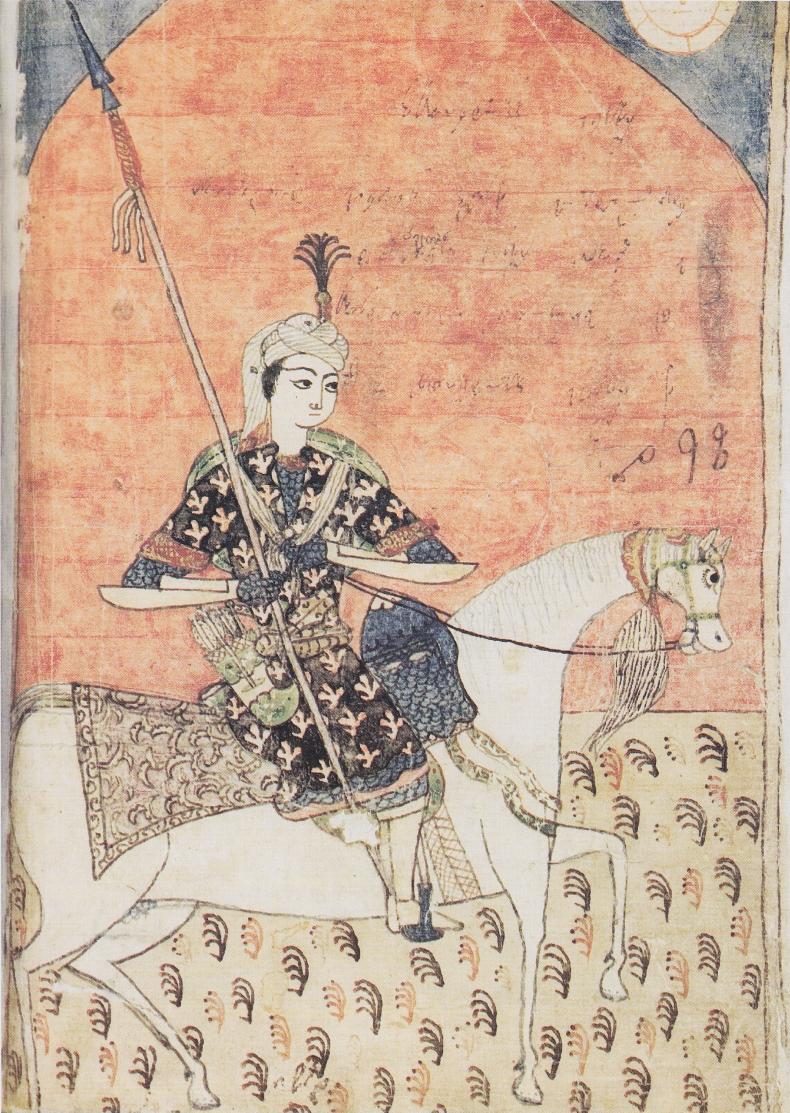Create an Amazon Business Account

Create an Amazon Business Account
Georgian miniature from a 17th century manuscript of Shota Rustaveliís poem,
The Knight in the Pantherís Skin (Vephkhistqaosani)

Fig. 14. Avtandil with Wawel-type helmet secured to the saddle pommel. Tavakarashviliís copy of The Knight in the Pantherís Skin, manuscript H599, f. 255. National Centre of Manuscripts of Georgia.
The Wawel-type helmet was very popular in Georgia and, slightly modified, it was in use for three or four centuries, until the end of the feudal period. This fact is referred to simultaneously and independently of each other by two sources in which the Georgia of the 1st half of the 17th c. is described: Mamuka Tavakarashviliís miniatures of The Knight in the Pantherís Skin34 and Christophoro Castelliís albums.
Tavakarashvili, Secretary of the King of Imereti, when kept prisoner at the court of Levan II Dadiani in Samegrelo in 1646, copied The Knight in the Pantherís Skin. In his miniatures two types of helmets are represented: the turban helmet (comparatively rarer) and the Wawel helmet with a slight modification. In miniature 255 a helmet secured on to the pommel of Avtandilís saddle, is analogous to the Wawel helmet: the shape of the dome, decorative eyebrows, aventail, rosette on the top of the helmet, shape of the crown, its upper part exactly repeating the ornament of the Wawel helmet35 (fig. 14). The warriors, depicted in a whole group of miniatures (138, 187, 199, 319. 341 and 429), also wear such helmets. A slight modification was introduced into the back of the helmet whose metal part extends downward, completely covering the back of the head, the upper part of the neck and the ears36. In separate cases in place of a globule, the top of the helmet is adorned with a small flag, which was popular in the late Middle Ages.
33 This is further corroborated by the representations of the Wawel-type helmets dating from a later period, they confirm my conjecture and refer to the fact that the artists were under a certain limitation when depicting helmets of a covered type. The discussion of the 17th-c. examples connected with this iconographic problem is presented below.
34 Manuscript H599, preserved at the National Centre of Manuscripts.
35 It is understandable that due to the small size, the artistís presentation of the trefoil ornament is simplified. It is noteworthy that Avtandilís outer garments are entirely covered with trefoil ornaments (miniatures 255; 300 and 310); in The Knight in Pantherís Skin Levan Dadianiís, Tarielís, Nestan Darejanís and Rostevanís clothes are also adorned with trefoil patterns.
36 It means that the Georgian helmet underwent the same transformation the European bascinet had undergone in the 14th c., beginning with the year 1330, it extended downward, covering the ears and the neck (Blair 1958, 67). It is difficult to say when it happened in Georgia, because, as a matter of fact, no information is available about the 15th-16th-c. helmets.
Source: pp.92-94, The Helmet from the Wawel Royal Castle Museum and its Place in the Evolution of Oriental Helmet by Mamuka Tsurtsumia
See also Georgian miniatures from a mid 17th century manuscript of Shota Rustaveliís poem, The Knight in the Pantherís Skin.
Georgian Cavalrymen by Italian missionary Don Cristoforo de Castelli, 17th Century.
Other Georgian Illustrations of Costume & Soldiers


